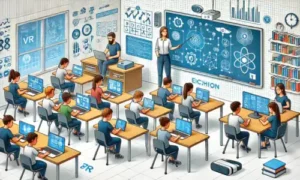Recently updated on January 17th, 2025 at 07:42 am
The Indian education system, with its rich history and diversified student population, presents numerous obstacles to meeting the expectations of the twenty-first century. As the world changes swiftly due to technology breakthroughs and shifting employment markets, there is an urgent need to adapt the education system to ensure that students are prepared for future difficulties. Here are numerous options for improving and upgrading India’s education system.
1. Use Technology to Enhance Learning

Digital Classrooms: Set up interactive learning environments with interactive technology like tablets, projectors, and smart boards. This accommodates a variety of learning styles and makes the classroom more entertaining.
Online Learning Platforms: Encourage the use of accessible resources and courses offered by Byju’s, Khan Academy, and Coursera, which are online learning platforms that enhance traditional education.
Learning Management Systems (LMS): To plan classes, monitor student progress, and help teachers and students communicate, schools can implement LMS.
2. Update the Course of Study

Skill-Based Education: Change the emphasis from rote memorization to skill-based learning through skill-based education. Incorporate practical skills and vocational training into the curriculum to improve employability.
STEM and STEAM Education: To promote creativity and innovation, place a strong emphasis on STEM subjects (science, technology, engineering, arts, and mathematics). Students who work on practical projects can better use their theoretical knowledge in practical settings.
Environmental Education: Include environmental studies in the curriculum so that pupils learn about conservation, climate change, and sustainability at a young age.
Also See: How Computer Assisted Learning
3. Emphasize holistic growth

Emotional and Social Learning: Include instruction in social skills and emotional intelligence in the curriculum. Students can be prepared for collaborative work contexts through programs that emphasize empathy, teamwork, and communication.
Physical Education and Mental Health: To guarantee general well-being, give priority to physical education and mental health initiatives. Mindfulness and yoga are two practices that help improve focus and lower stress.
Extracurricular Activities: To foster creativity, leadership, and teamwork outside of the classroom, and encourage involvement in clubs, athletics, and the arts.
4. Creative Evaluation Techniques

Continuous Assessment: Quizzes, projects, and presentations are used to evaluate students continuously, taking the place of high-stakes exams. This lessens the stress associated with exams and gives a more realistic view of students’ performance.
Portfolio-Based Assessments: Motivate students to build portfolios that highlight their projects, work, and development as individuals throughout time. This all-encompassing method of evaluation draws attention to each person’s areas of strength and growth.
Peer and Self-Assessment: Students should be taught to assess both their own and their peers’ work. This encourages self-reflection and critical thinking while advancing group learning.
5. Make Use of AI and Data

Data-Driven Insights: Track student performance and engagement with data analytics to enable tailored learning paths and focused interventions.
AI-Powered Learning Tools: Make use of AI tools that may give teachers and students immediate feedback, enabling them to swiftly discover their strengths and shortcomings.
Predictive analytics for student success: To guarantee the academic achievement of at-risk kids, use predictive analytics to identify them early and offer timely support.
6. Strengthen Training and Development for Teachers

Professional Development: Invest in continuous training programs for teachers that include new topic knowledge, instructional technologies, and teaching strategies. This keeps educators informed and inspired to use new ideas in the classroom.
Mentorship Programs: Set up mentorship programs in which more seasoned educators assist less seasoned ones. Improved teaching efficacy and the exchange of best practices are possible outcomes of this partnership.
Encourage Innovative Teaching: Give credit to educators who use creative and successful teaching strategies. This motivates teachers to try new things and modify their methods.
7. Encourage accessibility and inclusivity

Inclusive Education: Implementing policies that assist students with disabilities and learning difficulties would guarantee that they have equitable access to high-quality education. This is known as inclusive education. Teachers can effectively handle a variety of learning needs with the support of specialized training.
Balance between Rural and Urban: Create plans to guarantee that underserved and rural communities have access to quality teachers and educational materials. Educational inequalities can be closed through programs like online learning and mobile schools.
Language Diversity: Promote bilingual education by including regional tongues in addition to Hindi and English. This improves communication skills and fosters cultural understanding.
8. Encourage parental and community involvement

Community Partnerships: To improve resources and educational opportunities, work with nearby companies, non-governmental groups, and educational institutions. Participating in the community can give students access to internships and real-world experiences.
Parental Engagement: Encourage a close bond between parents and schools by keeping in touch and participating in school events. Parents can be empowered to assist their children’s learning by attending workshops on contemporary teaching techniques.
School Governance: Through local education committees and parent-teacher organizations (PTAs), involve parents and community members in school governance. Their opinions can influence school procedures and policies.
9. Promote Innovation and Research

School-industry partnerships: Through workshops, internships, and project partnerships, collaborate with businesses to expose students to how their studies are applied in the real world.
Innovation Labs: Establish research and innovation labs in schools so that students can work on ideas, experiments, and prototypes while developing their creativity and problem-solving abilities.
Promote Entrepreneurship: Establish entrepreneurship courses that equip students with the knowledge and skills necessary to start their businesses by teaching them about creativity, business principles, and critical thinking.
10. Put Adaptable Learning Models into Practice

Blended Learning: Blended learning is a hybrid approach that enables flexibility and a customized learning experience by fusing traditional classroom instruction with online learning.
Modular Learning: By letting students select courses according to their interests and professional aspirations, modular learning offers a more individualized educational experience that encourages enthusiasm and participation.
Self-Paced Learning: Include choices for self-paced learning so that students may go through the content at their leisure and make sure they understand the ideas before continuing.
Conclusion
The Indian educational system must be innovative to give pupils the abilities, know-how, and flexibility needed in the fast-paced world of today. Therefore, we can build an educational system that equips students for life, not just tests, by embracing technology, updating curricula, emphasizing holistic development, and encouraging inclusivity.
Moreover, communities, parents, legislators, and educators must work together to implement these advances. In doing so, we can create an educational system that stimulates critical thinking, encourages innovation, and ultimately equips the next generation to prosper in a world that is always changing.






